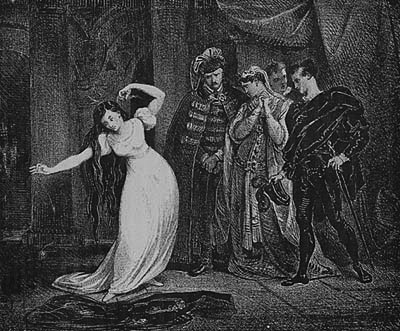
All aglow with excitement, writers of multiple-protagonist novels? I sincerely hope so, because last time, we whiled away an autumn Sunday evening discussing an array of strategies for folding spindling mutilating gently compressing a work of literature told from several distinct points of view — or by several different narrators — into (gusty sigh) the 1-page synopsis that so many agency guidelines and contest rules seem to be requiring these days.
And what did the golden rule of not driving yourself crazy in a valiant attempt to squish 400 pages of narrative told from 8 perspectives into 1 page of readable text? Not those panicked 40-pages-boiled-down-to-a-sentence generalizations so popular with first-time synopsizers everywhere, but not even trying to replicate the narrative complexity of the book in a space that scanty. Instead, in a 1-page synopsis for a multiple-perspective book, tell the story of the book, not of the individual protagonists.
I suspect that conclusion did not altogether astonish those of you who had been following the rest of last weekend’s expedited Synopsispalooza posts: as we saw in Saturday morning’s post on 1-, 3-, and 5-page novel synopses, Saturday evening’s dizzying array of memoir synopses, and Sunday morning’s multiple takes on a nonfiction synopsis, a 1- or 2-page synopsis has different goals than its longer counterparts.
Oh, the primary purpose of any query or submission synopsis, regardless of length, is to generate a great longing in our old pal, Millicent the agency screener, to see all or part of the actual manuscript, of course, but in a 1-page synopsis, all a novelist really has space to pull off is to demonstrate the book’s central conflict, the primary characters involved with it, and what they have to gain or lose from it. Preferably entertainingly, and ideally, in a voice and tone similar to that of the book.
Or, to put it in the checklist format we’ve been embracing throughout Synopsispalooza, a 1-page synopsis should:
(1) introduce the major characters and premise(s),
(2) demonstrate the primary conflict(s),
(3) show what’s at stake for the protagonist(s), and
(4) ideally, give some indication of the tone and voice of the book.
Those expectations remain basically the same, regardless of how many protagonists or narrators any given manuscript might happen to be able to boast. It’s not as though a querier, submitter, or contest entrant can shout at Millicent or Mehitabel, “Wait — my manuscript has more narrators than all of those other queriers/submitters/competitors for a blue ribbon in your fine literary contest. It’s only fair to give me more space for my synopsis, since I have more to summarize. About ten times as much should be about right,” and expect her to waive any pre-set length restrictions.
Oh, s/he can shout it until s/he is blue in the face, if s/he wants to give Millicent and Mehitabel a good laugh. That one should have ‘em rolling in the aisles. But the instant they stop chuckling, either will say, “No, but seriously, where’s your 1-page synopsis?”
So just tell the story of your book, as any other novelist would. As we saw last time, a successful 1-page synopsis for a multiple-perspective novel need not — and should not — contain any discussion of the narrative choices at all. To revisit our favorite plotline:

Yes, this 1-page synopsis would work equally well for a single-voiced telling of HAMLET as for one that followed Hamlet, his father, his mother, Ophelia, and Horatio around in the tight third person in alternating chapters, now that you mention it. Or even, since a novel synopsis should always be in the third person, no matter what the narrative voice of the book might be, a version where Ophelia and Hamlet narrate in the first person, Hamlet, Sr. and Gertrude’s perspectives are presented in the third person, and the reader is implicitly drafted into operating as both a castle guard and Greek chorus throughout versions told in the second person plural.
The possibilities are endless. A very flexible document, that 1-page synopsis.
Actually, since the synopsis is not the proper place to be discussing point of view choices, anyway, all of you multiple perspective-mongers could extend the same logic to a 3-, 4-, or 5-page synopsis: tell the book’s story precisely as you would if the manuscript did not feature interestingly different point-of-view choices. Seriously, it could work, and very well, too.
Do those hundreds of pencils, pens, and wadded up pages of synopsis draft flying in my general direction mean that some of you don’t believe me? Okay, let’s try an experiment: take a gander at this 3-page synopsis of the same story — and, as always, if you find you are having trouble making out the individual words, try holding down the COMMAND key and pressing + to enlarge the image.
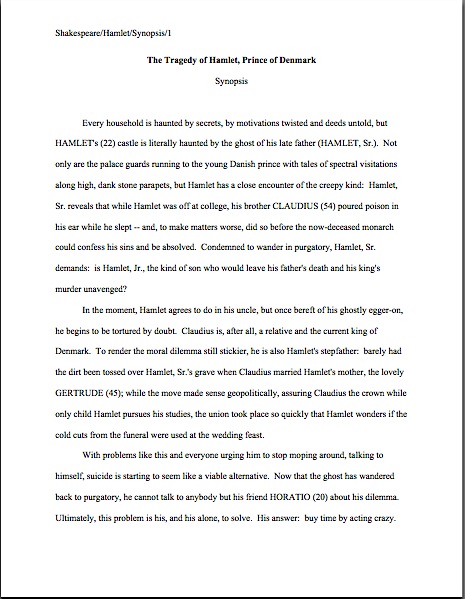
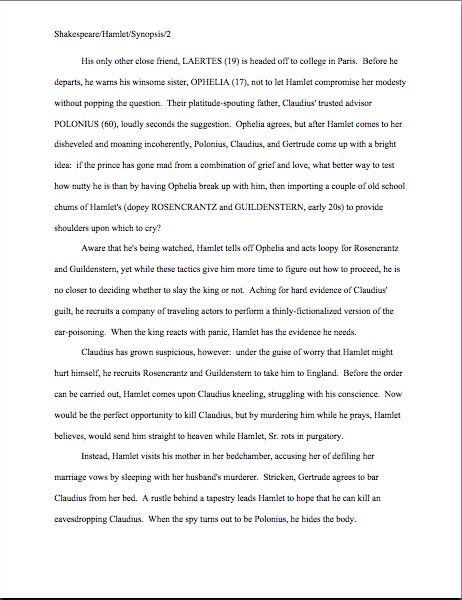
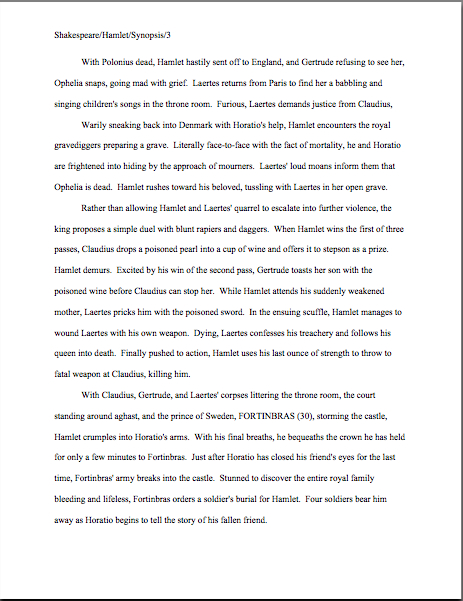
All through? Excellent. Now let me ask you: how does the manuscript described in that synopsis tell the story? Is it written in the tight third person? A distant third person? Is it in the voice of an omniscient narrator, or the voice of one of the characters?
Come on, admit it: it’s possible that the book is told in the voices of several of the characters, isn’t it?
Again, that’s not entirely accidental, since a novel synopsis for any of those narrative choices would need to be written in the third person, rather than the voice(s) of the book, and eschew English Lit-class discussion of protagonists and antagonists, right? In fact, any 3-, 5-, or even 8-page novel synopsis could share essentially the same structure — and definitely shares the same goals.
All together now — a longer synopsis should:
(1) introduce the major characters and premise(s),
(2) demonstrate the primary conflict(s),
(3) show what’s at stake for the protagonist(s),
(4) show the central story arc(s) through BRIEF descriptions of the most important scenes.
(5) show how the plot’s primary conflict(s) is resolved.
(6) ideally, give some indication of the tone and voice of the book.
#6 just put some wind back into some diversity of voice-lovers’ sails, didn’t it? “But Anne,” the full-sailed crow triumphantly, “aren’t you hoist with your own petard? How can I possibly demonstrate the voice of the book in my synopsis when my novel is written in 14 distinctly different voices? Obviously, I’m going to need to reserve some page space to explain that — because, equally obviously, I don’t want my beautifully differentiated array of perspectives to be mistaken for some manuscript told entirely from (ugh!) one point of view.”
I hate to be the one to break it to you, but Millicent expects voice and perspective choices to be a pleasant surprise not revealed to her until she actually starts reading the manuscript. So no matter how cleverly constructed your 14 voices might be — and kudos if you’ve managed to make each distinct; after 2-3, multi-voiced narratives often begin to blur a trifle — the synopsis is not the right place to bring them up.
I feel your pain, though, former crowers: this approach probably sounds an awful lot like being told to ignore all of your protagonists but one. “Here we go again,” you’re probably muttering under your breath, “expecting my book to be just like everybody else’s: the story of an interesting person in an interesting situation. By definition, though, a GOOD multiple-protagonist novel is the story of LOTS of interesting people in LOTS of interesting situations! How can I possibly choose?”
How about by not choosing to privilege one protagonist over the others? Even in a 3- or 5-page synopsis, your best bet is to tell the story of the book, not the various stories of the characters.
Hey, you did it for the 1-page synopsis, right?
Stop wincing; repeating that nifty trick for the higher dives of the longer synopses may not be as hard as you think. For a novel with multiple protagonists to work, it must have an underlying unitary story — necessarily, unless the chapters and sections are a collection of unrelated short stories. (Which would make it a short story collection, not a novel, and it should be queried and submitted as such.) Even if it is told from the point of view of many, many people, there is pretty much always some point of commonality.
That commonality makes far more sense as focus of your synopsis than many characters’ perspectives it takes to tell the story in your book. Strip the story to its basic elements, and talk about that for 3-5 pages. To be absolutely blunt about it, at the synopsis stage, you’ll probably have an easier time pleasing Millicent with a simplified version of a complex storyline, anyway.
Why, you demand in horrified tones? Well, there’s a practical reason — and then there’s a different kind of practical reason.
Let’s take the most straightforward one first: from Millicent’s point of view, once more than a couple of characters have been introduced within those first couple of sentences, new names tend to blur together like extras in a movie. That’s even more likely to happen in a pitch — unless the pitcher makes it absolutely clear right off the bat how all of those names are all tied together, the pitch-hearer’s eyes will begin to glaze over.
How might that affect even a very careful synopsizer of a multiple-protagonist plot? As I mentioned earlier in Synopsispalooza, it’s actually fairly common for novel synopses to talk about several characters in some detail, leaving Millicent to guess which is the main character. As a matter of expedience, then, most experienced Millicents will simply assume that the first character mentioned by name in a synopsis is the protagonist.
Well might you gasp, writers of multiple points of view. If a synopsis for a multiple protagonist novel were written to be purely reflective of the order of events in the plot — the most popular means of structuring a fiction synopsis, always — and the person who happens first to take action on page 1 is not the primary plot-mover in the rest of the book, Millicent is likely to wonder where he’s gone. She’s also, unfortunately, prone to stop reading if the welter of names gets too confusing.
Yes, yes, I know: for writers of character-heavy prose, this may seem grossly unfair, but try to picture what’s going through Millicent’s head just before she makes the decision to move on to the next query or submission packet. She’s been reading packets for hours on end; if all of the named characters from all of those synopses suddenly rushed into her office, the floor would collapse. Then, with all of those proper names and premises swirling around in her head, her next synopsis begins like this:
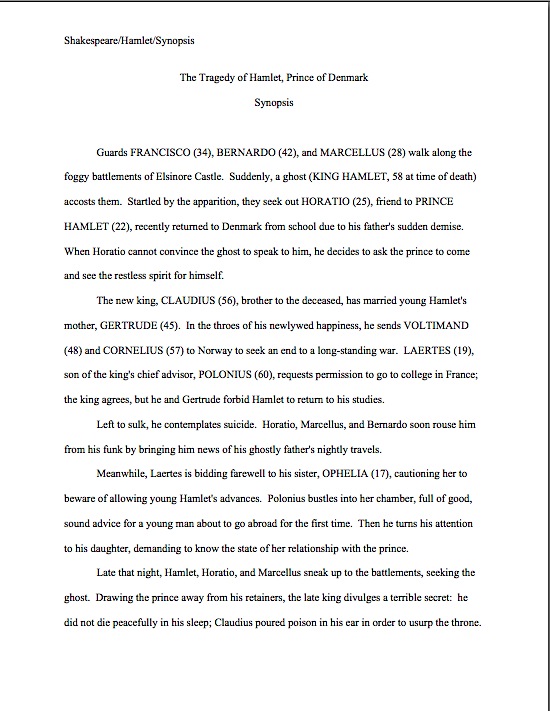
Come on, own up: all of those names had your head spinning by the middle of the second paragraph, didn’t they? Even the most open-minded professional reader would be likely to zone out at that point. There’s just too much to remember.
To those of you who are chortling at the notion that remembering twelve names in two paragraphs might strike anyone as being a heavy intellectual burden, I have a question for you: if you didn’t already know what the play was about, which of those 12 characters would you think was the most important to the story, based upon this account?
Not so easy when you’re on the other side of the submission packet, is it? The play’s not called FRANCISCO, GUARD OF ELSINORE, campers — but I think we can all begin to appreciate why a weary-eyed Millicent in her fifth hour of opening query packets might leap to that conclusion.
Still not convinced that a laundry list of plot points is not the best synopsis strategy for a complex narrative like yours? Including that much detail is an incredibly inefficient use of space. Lest you doubt: the full page above takes us only up to midway through Act I, Scene V; HAMLET has five acts.
At that rate of summation, how many pages would the synopsis have to be to contain the whole plot? 15? 20?
No wonder so many writers of multiple POV novels find themselves banging their foreheads against their computer monitors in frustration over requested synopses, shrieking, “5 pages? That’s impossible! I mean, if they allowed me 10, I might have a chance, but…” A completely understandable reaction, if the goal actually were to boil down the entire plot and narrative choices of a 500-page novel down to those 5 pages.
Fortunately, it’s not. While I sympathize heartily with the angst those head-bangers experience, the problem here isn’t really the length of the synopsis — it’s the writer’s insistence upon seeing the plot and the narrative structure as so inextricably interwoven that story cannot be broken out from it. Thus the frustration: the task of summarizing everything in the manuscript is, in fact, an impossible one.
First-time pitchers often set themselves the same mile-high hurdle, by the way. They charge into pitch meetings and tell the story as written in the book, concentrating on each perspective in turn as the agent or editor stares back at them dully, like a bird hypnotized by a snake. And ten minutes later, when the meeting is over, the writers have only gotten to the end of Chapter 4.
Out of 27.
How does this happen? Thinking of the book as an integrated whole incapable of dissection, mostly — that, and not having much practice talking about their work with professionals, or even other writers. I’m perpetually astonished by how often first-time pitchers have never talked about their books out loud before approaching an agent. Not having had the experience of observing just how quickly the average hearer’s eyes glaze over, they think that the proper response to the innocent question, “So, what’s your book about?” is to reel off the entire plot.
And I do mean ENTIRE. By the end of it, an attentive listener would know not only precisely what happened to the protagonist and the antagonist, but the neighbors, the city council, and the chickens at the local petting zoo until the day that all of them died.
Poor strategy, that, in either a pitch or a synopsis. If you ramble on too long in either, the person on the receiving end may well draw some unflattering conclusions about the pacing of your storytelling preferences, if you catch my drift.
Word to the wise: keep it snappy, and emphasize the storyline.
If you are totally at a loss about how to begin to figure out what is essential, enlist the assistance of a sympathetic friend who has not yet read your manuscript. (No fudging on this point, or the exercise won’t work.) Ideally, you’ll want to choose someone with a fine memory and a good sense of humor, as the favor you are about to ask is likely to try her patience.
Find her a comfortable seat, hand her a pad of paper and a pen, and ask her to take notes on the story you are about to tell. Set a kitchen timer for 15 minutes and start talking about your book.
If the time runs out before you have finished with the story, have her tear up her notes before your doubtless watering eyes. (Yes, it’s cruel, but nobody ever said trimming a complex plot was easy, right?) Then reset the timer and start again at the beginning of the book.
Once you have made it all the way through the plot in the allotted time, take a quick glance at her notes, your handy highlighters in hand. Mark every reference to perspective; do the same with any bottom-lining summary statements about characterization along the lines of Bertrand was a busy man. Hand the pad back to your long-suffering friend, grab your own notepad, and ask her to tell the story back to you, leaving out the highlighted parts. Make a note of every major plot point and scene she mentions — and no fair correcting her if she leaves out elements you consider essential.
After you have praised your helpful friend to the skies, promised to heap her with appropriate tokens of your undying gratitude, and sent her home for some well-deserved rest, take a long, hard look at your notes. If someone unfamiliar with the book heard just those bullet points, would he be able to follow the story? If not, what patches would be necessary before he could?
If your list of plot points does not yield an outline that you can use as a structure for a 3-, 4-, or 5-page synopsis, don’t be downhearted — that wasn’t the point of the exercise. The goal here is to help you become comfortable of thinking of your manuscript as a story, not as a collection of words on paper.
Didn’t see that coming, did you? I freely admit it: this is not the kind of practical exercise I usually assign, but it’s essential for anyone tackling the daunting task of writing a synopsis for a multiple-protagonist novel to stop thinking of the book as a collection of disparate characters’ stories. There’s a communal story there somewhere. The more often you tell your story out loud beginning to end — and, I must say it, the more sensitive you become to the points at which your hearer begins to fidget with impatience because you’re going into too much detail — the more prepared you will be to sit down and write a synopsis that focuses upon that story, not the narrative tricks.
I know that it’s counterintuitive, but in a synopsis for a complex plot about complex characters, the fewer the narrative tricks, the better, generally speaking. Remember, yours is almost certainly not going to be the only synopsis that Millicent has read recently, and if she is even remotely backlogged, she will be skimming: drawing your plot in broad strokes is more likely to draw her in than super-intense blocks of minute twists.
One of the simplest ways to steer her in the right direction is to talk about only one or two characters in the opening paragraph, setting the stage, as it were, for the rest of the synopsis to be about those people. Clearly, this may not be a viable solution for a novel about, say, 7 or 8 people, unless there happens to be a scene near the opening of the book where they all appear.
In practice, the opposite is often the case: many, many multiple perspective manuscripts don’t bring all of the protagonists together until the final chapter or scene. Yet another reason that organizing the synopsis to be slavishly reflective of the book’s running order, including each and every plot point, may not be helpful at all. In fact, it might even be harmful to the story’s clarity.
But before any of you run rushing I hasten to add: that doesn’t mean that it’s a good idea to open your synopsis with, Once upon a time, there were 18 protagonists…, either. Or even, in the case of our last example: My version of the Hamlet legend is told from the points of view of five protagonists: Prince Hamlet, his father, his mother, his girlfriend, and his best friend.
Oh, I realize that stating the perspective rules up front might seem like the most straightforward way to minimize the probability of Millicent’s spending the first three pages of your 5-page synopsis waiting for Francisco and Bernardo to dominate the plot once more. I also, from years of teaching pitching and querying classes, am aware that to most writers of multiple-protagonist novels, the point of view choices are the very first thing mentioned when describing their books.
If the number of voices is not the most important fact for Millicent to grasp about the manuscript, this emphasis seems to imply, it’s certainly the most interesting. Actually, from the writer’s point of view, there’s an excellent reason to think of a multiple POV manuscript in this manner: the different perspectives are an integral part of the story being told.
From the writer’s perspective, the structural choices are indeed monumentally important. But from a marketing point of view — which is to say: the view of anybody who has worked at an agency or publishing house, ever — they’re substantially less so.
Don’t believe me? Okay, when’s the last time you walked into a bookstore, buttonholed a clerk, and asked, “Where can I find a good book told from many points of view? I don’t care what it’s about; I just woke up this morning yearning for multiplicity of perspective.”
I thought not. Although if you want to generate a fairly spectacular reaction in a bored clerk on a slow day, you could hardly ask a better question.
Yes, the reader’s experience of the story is going to be inextricably tied up with how it is written — and yes, that would be a problem, if Millicent genuinely expected a 3- or 5-page synopsis to provide her the same experience as reading the book. Fortunately for the sanity of synopsizers everywhere, however, she knows the difference between a 450-page manuscript and a 5-page synopsis of it.
When I say that a good synopsis gives some indication of the voice and tone of the book, I’m not referring to the literal voices that make up a multi-narrator narrative. I’m talking about literary voice: the way of using words, the rhythm, the vocabulary choices, the sentence structures. In a smoothly integrated multi-voiced narrative, the authorial voice carries over into each and every protagonist’s narration, right?
What I’m suggesting, then, is that for the purposes of writing your longer synopsis, you should mentally separate the overall story from how you have chosen to tell it in the book; continuing to think of them as inextricably linked will render writing a compelling overview significantly more difficult. Instead, try creating an new character — an omniscient third-person narrator who stands outside the story, yet knows everything that’s going on.
Why, that’s you, isn’t it? Who better to tell the book’s story to Millicent in the synopsis?
What’s that you’re wailing, campers? That this advice would require you to come up with yet another narrative voice? Why is that problematic, when part of the point of shoving this synopsis into your query or submission packet is to show Millicent that you can write. If you can — and you can, can’t you? — telling the book’s story in your own voice as the novel’s creator, rather than from the POV of any individual character, should be, if not a walk in the park, at least a doable jog several times around the duck pond.
And, honestly, isn’t it a more interesting challenge than either trying to show each protagonist’s initial situation and conflict in succession in such a short amount of page space or just listing the book’s events in chronological order? It’s certainly more likely to show off your writing talents than the usual first-time synopsis-writer’s method of just summarizing everything in the book as bluntly as possible.
I mean, you could conceivably pitch Barbara Kingsolver’s multiple-narrator THE POISONWOOD BIBLE as, “Well, a missionary takes his five daughters and one wife to the middle of Africa. Once they manage to carve out a make-do existence in a culture that none of them really understand, what little security the daughters know is ripped from them, first by their father’s decreasing connection with reality, then by revolution.”
That isn’t a bad summary of the plot, but it doesn’t really give much of a feel for the book, does it? The story is told from the perspectives of the various daughters, mostly, who really could not agree on less and who have very different means of expressing themselves.
And that, really, is the charm of the book. But if you’ll take a gander at Ms. Kingsolver’s website, you’ll see that even she (or, more likely, her publicist) doesn’t mention the number of narrators until she’s already set up the premise. Any guesses why?
Okay, let me ask the question in a manner more relevant to the task at hand: would it make for a strong synopsis tell the story in precisely the order it is laid out in the book, spending perhaps a paragraph on one narrator, then moving on to the next, and so on? We tried that yesterday, recall; it looked a little something like this:
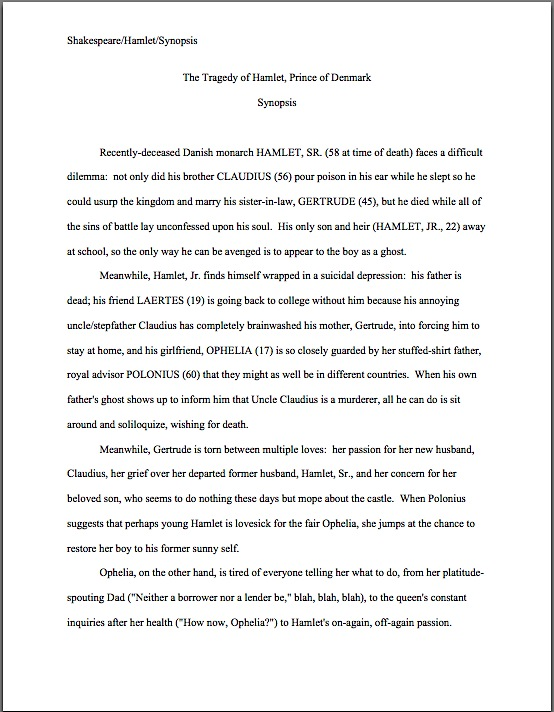
All of those perspectives are distracting from the story, are they not? Not only is the plethora of characters likely to confuse Millicent, but the structure here is repetitious: in granting each protagonist a separate set-up, the synopsis necessarily revisits the premise of the book over and over again. Is that really the best way to convince Millicent that here is a strong story by a writer worth reading?
Don’t let the innovative structure and perspective choices of your book become a liability in your synopsis; you want your storytelling skills to shine. Instead, highlight the major characters by ramping up the character development. And why not show off your good writing and trenchant insights through the inclusion of unexpected little details here and there that she won’t have seen before?
You’re expecting me to toss off a 5-page synopsis for a multiple-protagonist version of HAMLET abounding in such details and character development, aren’t you? Well, I’m not going to do it — and not merely because this post is running awfully long, even by my standards. After all, those charming little touches, vivid images, and startling insights into the human condition are going to be different for each authorial voice, aren’t they? So I won’t encourage you to copy me; I’m sure your own literary voice is just itching to come out and play.
Next time, we shall once again be discussing synopsis length — and, if I know myself, probably a few more concrete examples as well. Keep up the good work!